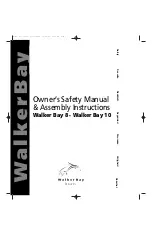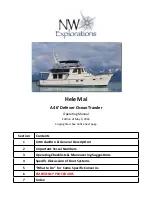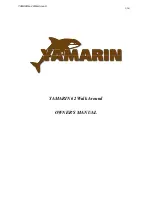
3.1
CONTINUED
Special attention should be given to the initial stretch of the
rigging, especially after the first sail in a strong breeze. In
windy conditions it is actually desirable to have the mast head
"fall-off" slightly to leeward, giving the mast a smooth, even
curve from head to deck. After a few more sails in strong
breezes, the rigging should be checked again for tune, as
additional stretch will occur.
3.2 MAINSAIL GEAR
In addition to spars, the mainsail gear consists of a stainless
steel braided tail halyard, cunningham line, topping lift,
internal outhaul, mainsheet, and ball bearing traveller. The
cleat and an optional winch, if ordered, are mounted on the
starboard side of the mast. After hoisting the main, insert a
pre-sprung, cotter pin in the hole located in the luff groove
just above the gate so that the head of the pin prevents the
slides from leaving the luff groove when the sail is lowered.
The outhaul consists of an internal tackle with a purchase of
5:i giving ample power to adjust foot tension when under sail.
The outhaul is controlled from the bottom of the boom near the
gooseneck to allow adjustment even when the boom is eased such
as on a broad reach.
The mainsheet consists of a six-part tackle terminating at a cam
cleat on the traveller car. The ball bearing traveller is
conveniently located on the bridge deck. Athwartship control is
achieved by pushing the blocks and car to the desired position
on the traveller and securing it there with one or both of the
spring loaded traveller stops.
The main cunningham dead ends on an eye strap on the port side
of the mast. It is passed through the cunningham cringle then
down to a clam cleat on the opposite side of the mast. As the
wind freshens the cunningham can be taken in to help control
draft and keep it forward in the sail.
After hoisting sail, remember to ease the topping lift at the
aft end of the boom so that the mainsail can be properly
sheeted.
3.3 GENOA GEAR
The trend in modern yacht design has been to smaller mainsails
and larger jibs or "Genoas". Usually any sail that overlaps the
mast is considered a Genoa and is identified by the amount of
the overlap.
Summary of Contents for 299
Page 1: ......
Page 2: ......
Page 53: ......
Page 54: ......
Page 55: ......
Page 56: ......
Page 57: ......
Page 58: ......
Page 59: ......
Page 60: ......
Page 61: ......
Page 62: ......
Page 63: ......
Page 64: ......
Page 65: ......
Page 66: ......
Page 67: ......
Page 68: ......
Page 69: ......
Page 70: ......
Page 71: ......
Page 72: ......













































